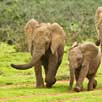National parks
© Copyright 2025-26 by GTI Travels Pvt. Ltd.
The forest of Gir got the designation of a Wildlife Sanctuary in 1965 and later in 1975 declared as the National Park of India. Spreads in a large area of around 1412 sq km, the Gir National Park boasts of being the habitat of more than 38 mammal species, around 300 species of avifauna, 37 species of reptiles and a whopping above 2000 species of insects.

Being an exclusive natural abode in the world for the Asiatic Lions, the hilly, arid and deciduous forest of Gir National Park is the prominent wildlife destination in the western region of India. The forest of Gir got the designation of a Wildlife Sanctuary in 1965 and later in 1975 declared as the National Park of India. Spreads in a large area of around 1412 sq km, the Gir National Park boasts of being the habitat of more than 38 mammal species, around 300 species of avifauna, 37 species of reptiles and a whopping above 2000 species of insects. The Jeep Safari organized in the park allows wildlife enthusiasts to explore this wilderness and get the sighting of the King of the forest, the Lions.

Located in the Sasan Gir at the equal distance from the nearby cities of Veraval and Junagarh, the Gir National Park is visited by a large number of wildlife lovers, especially the Lion lovers, every year from all over the world. One can easily spot the Lion roaming or just taking a nap with its family during your Jeep Safari in the park. Exploring the thick raw forest of Gir while on your wildlife holiday can be a memorable experience as it is hard to find such a rich flora and fauna, pure air and tranquility near the big cities.

The rich and varied flora and fauna of the Gir forest attract Nature loving tourists and wildlife enthusiasts to visit this beautiful forest, again and again, whenever get the time to recharge and refresh their tired mind with the blissful proximity of the raw Nature. A large number of 523 Asiatic Lions are the top of the food chain in this dense deciduous forest which also inhibits the wild animals such as Leopards, various species of Deer, Striped Hyena, Jackal, Indian Fox and many other small wild animals. The Gir is also home to the four-horned Antelope named Chowsingha - a rare species of antelope found exclusively in the park.

The park is home to more than 300 bird species due to which the Indian Bird Conservation Network has declared the park as an important bird area. One can spot the birds like changeable hawk-eagle, Bonelli eagle, crested serpent eagle, greater spotted eagle, tawny eagle, steppe eagle, lesser spotted eagle, imperial eagle, gray-headed fish eagle, Pallas's fish eagle, peregrine falcon, red-headed falcon, Laggar falcon, white-eyed buzzard, oriental honey-buzzard and many other Raptors in the park. Also, the sighting of the endangered birds like Indian white-backed and long-billed vultures which are conserved in the habitat of the Gir Forest can be an overwhelming experience for the bird lovers.

The park is also an attraction for being the home to a large number of reptiles. The Kamleshwar reservoir in the Gir Sanctuary is the prime location to spot these dangerous reptiles. The park boasts of having more than 40 different species of the Reptiles and Amphibians group in its habitat. The Marsh Crocodile or Mugger is the prime reptile species found in the Gir forest along with the big venomous snakes like King Kobra, Russell’s viper, Saw-scaled viper and the Krait. The flora of the Gir Park comprises of 400 species of deciduous trees and plants which make the dense green cover of the forest.